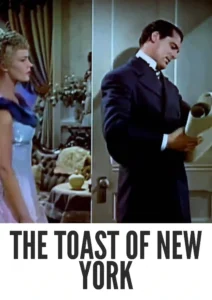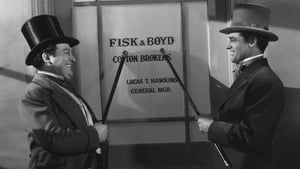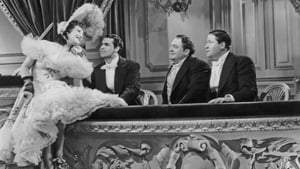Contact: [email protected]
Video Sources 0 Views
- The Toast of New York


Synopsis
Table of Contents
ToggleReview: In The Toast of New York (1937) – A Captivating Journey through Gilded Age New York

Introduction
“In The Toast of New York” (1937) stands as a timeless testament to the allure of historical dramas and the grandeur of Gilded Age New York. In this article, we’ll delve into the significance of this early cinematic gem, exploring its impact on audiences and its lasting legacy in the realm of historical epics.
Check The Full Colorized Movies List
Check Our Colorized Movies Trailer Channel
Understanding The Toast of New York 1937: Director, Cast, and Genre
Directed by the visionary Rowland V. Lee, “In The Toast of New York” (1937) showcases his skill in bringing the past to life on the silver screen. The film boasts a stellar cast, including Edward Arnold, Cary Grant, and Frances Farmer, whose captivating performances breathe life into the characters of yesteryear. Blending elements of drama, romance, and adventure, “In The Toast of New York” (1937) transports viewers to a bygone era of opulence and intrigue, where fortunes are made and lost in the blink of an eye.
Exploring the World of The Toast of New York 1937: Plot and Characters
At its core, “In The Toast of New York” (1937) follows the rise and fall of a group of ambitious financiers as they strive to corner the market on gold during the tumultuous years following the Civil War. Against the backdrop of Gilded Age New York, we witness the triumphs and tribulations of larger-than-life characters whose fortunes hang in the balance. As alliances are forged and betrayals are revealed, the stage is set for a showdown that will determine the fate of an era.
The Art of Film Colorization
Film colorization serves as a transformative tool that enhances the visual experience of classic movies, breathing new life into timeless stories and captivating audiences with vibrant hues. By digitally adding color to black and white films, colorization allows viewers to immerse themselves in the rich tapestry of cinematic worlds, exploring every nuance and detail with fresh eyes and renewed appreciation.
Early Colored Films: A Brief History
The history of colored films traces its roots back to the early days of cinema, with filmmakers experimenting with various techniques to add color to their creations. From hand-tinted frames to early Technicolor processes, the evolution of colored film has been marked by innovation and ingenuity, paving the way for the development of modern colorization techniques that continue to captivate audiences to this day.
The Toast of New York 1937 and Its Early Colored Version
The decision to release “In The Toast of New York” (1937) in a colorized format was met with both excitement and trepidation. While some welcomed the opportunity to experience the film in vibrant color, others expressed concerns about the potential impact on its visual aesthetic. Nevertheless, the early colored version of “In The Toast of New York” (1937) offers viewers a fresh perspective on the grandeur and glamour of Gilded Age New York, enhancing its immersive qualities and captivating audiences with its luminous beauty.
The Debate Over Film Colorization
The debate over film colorization continues to divide audiences and critics alike, with proponents praising its ability to breathe new life into classic movies and introduce them to a new generation of viewers, while detractors argue that it compromises the artistic integrity of the original work and diminishes its historical significance. As the debate rages on, filmmakers and audiences alike are left to ponder the merits and drawbacks of colorization in the ever-evolving landscape of cinema.
Examining The Toast of New York 1937 as an Early Colored Film
As with any colorized classic, the impact of colorization on “In The Toast of New York” (1937) is a matter of personal interpretation. Some may argue that it enhances the film’s visual appeal and immerses viewers in its world, while others may feel that it detracts from the stark beauty of the original black and white version. Regardless of one’s stance on the issue, there’s no denying the enduring power of “In The Toast of New York” (1937) as a timeless historical epic that continues to captivate audiences with its grandeur and spectacle.
Influence and Legacy: The Toast of New York 1937’s Impact on Cinema
“In The Toast of New York” (1937) has left an indelible mark on the world of cinema, inspiring countless filmmakers and captivating audiences with its sweeping narrative and sumptuous visuals. From its unforgettable performances to its breathtaking cinematography, the film continues to resonate with viewers of all ages, reaffirming its status as a beloved classic of the historical drama genre.
Director’s Cinematic Legacy: Beyond The Toast of New York 1937
Rowland V. Lee’s influence extends far beyond “In The Toast of New York” (1937), with a diverse body of work that continues to captivate audiences around the globe. From “The Count of Monte Cristo” to “Son of Frankenstein,” Lee’s films are celebrated for their epic scope, rich characterizations, and timeless themes, solidifying his legacy as one of the preeminent directors of Hollywood’s Golden Age. Through his groundbreaking work, Lee has left an indelible imprint on the world of cinema, inspiring generations of filmmakers to follow in his footsteps.
Themes Explored in The Toast of New York 1937
“In The Toast of New York” (1937) explores a myriad of themes, from the pursuit of wealth and power to the cost of ambition and the fleeting nature of success. Through its richly drawn characters and sweeping narrative, the film invites viewers to ponder the complexities of human nature and the enduring allure of the American Dream. As audiences immerse themselves in the world of “In The Toast of New York” (1937), they are reminded of the universal truths that bind us together and the timeless struggles that define the human experience.
Reception and Controversy Surrounding The Toast of New York 1937
Upon its release, “In The Toast of New York” (1937) received widespread critical acclaim, with many praising its epic scope, stunning visuals, and compelling performances. However, the decision to release the film in a colorized format sparked debate among purists, reigniting the age-old discussion surrounding film preservation and artistic integrity. Despite the controversy, “In The Toast of New York” (1937) remains a beloved classic that continues to resonate with audiences of all ages, reaffirming its status as a timeless masterpiece of the historical drama genre.
Where to Watch The Toast of New York 1937 Online
For those eager to experience the timeless grandeur of “In The Toast of New York” (1937), the film is readily available on popular streaming platforms such as Netflix, Amazon Prime, and Hulu. Whether you choose to watch it in its original black and white format or the early colored version, “In The Toast of New York” (1937) promises to transport you to a world of opulence and intrigue, where the human spirit shines brightest in the darkest of times.
FAQs About The Toast of New York 1937
Q: Is “In The Toast of New York” (1937) based on a true story? A: Yes, “In The Toast of New York” (1937) is loosely based on the real-life exploits of James Fisk, Jr., a flamboyant financier who rose to prominence during the Gilded Age.
Q: Who are the main actors in “In The Toast of New York” (1937)? A: “In The Toast of New York” (1937) features an ensemble cast led by the talented Edward Arnold, Cary Grant, and Frances Farmer, whose captivating performances bring the characters of Gilded Age New York to life with verve and vitality.
Q: What awards did “In The Toast of New York” (1937) win? A: While “In The Toast of New York” (1937) did not win any major awards, it received critical acclaim for its epic scope, stunning visuals, and compelling performances, solidifying its status as a beloved classic of the historical drama genre.
Q: Why was “In The Toast of New York” (1937) released in a colorized format? A: The decision to release “In The Toast of New York” (1937) in color was made to introduce the film to a new generation of viewers and enhance its visual appeal for modern audiences. While the choice to colorize the film sparked debate among purists, it ultimately allowed “In The Toast of New York” (1937) to reach a wider audience and ensure its continued relevance in the annals of cinematic history.
Conclusion
As we bid farewell to the opulent world of Gilded Age New York, let us remember the enduring legacy of “In The Toast of New York” (1937) and the timeless truths it imparts. Through its sweeping narrative, compelling characters, and sumptuous visuals, the film serves as a poignant reminder of the enduring allure of history and the power of cinema to transport us to another time and place.
So, whether you’re a seasoned cinephile or a casual moviegoer, take a moment to revisit “In The Toast of New York” (1937) and experience the magic of Gilded Age New York as never before. For in the grandeur and spectacle of its epic tale, you’ll find a treasure trove of wisdom and wonder that will stay with you long after the credits roll.












